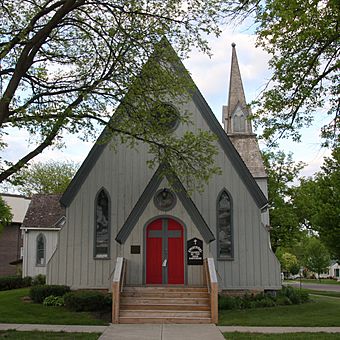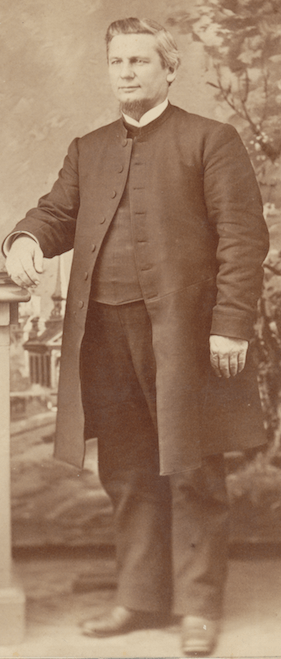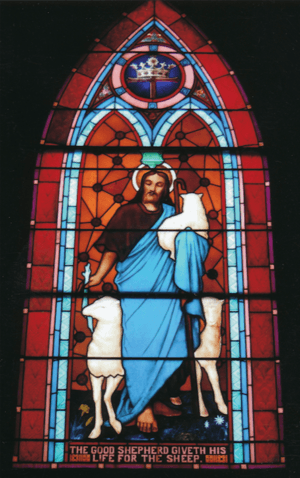Church of the Good Shepherd-Episcopal (Blue Earth, Minnesota) facts for kids
Quick facts for kids |
|
|
Church of the Good Shepherd--Episcopal
|
|

The church seen from the west in 2016
|
|
| Location | Moore and 8th Streets, Blue Earth, Minnesota |
|---|---|
| Area | 7.5 acres (3.0 ha) |
| Built | 1872 |
| Architect | Rev. Solomon S. Burleson |
| Architectural style | Gothic Revival |
| MPS | Faribault County MRA |
| NRHP reference No. | 80004257 |
| Added to NRHP | May 23, 1980 |
The Church of the Good Shepherd Episcopal is a very old church building. It is located at Moore and 8th Streets in Blue Earth, Minnesota. This church is the oldest one still standing in the community.
It is built in a style called Rural Gothic architecture. This means it looks like older European churches but is simpler. In the 1970s, fewer people attended the church. Because of this, regular services stopped. In 1981, the last three members gave the building to the Faribault County Historical Society.
Since then, the church has been used for special events. It hosts seasonal services, Christmas concerts, weddings, and funerals. The church was added to the National Register of Historic Places in 1980. This means it is an important historical site.
Contents
Starting the Church Community
Blue Earth was founded in 1856. Many early settlers were Methodists, but Episcopalians also moved there. The first Episcopal church service in Blue Earth happened on December 10, 1867. It was held in the Presbyterian church building.
In 1870, Bishop Henry Whipple asked Reverend Solomon Stephens Burleson to visit Blue Earth. Reverend Burleson was a pastor in Northfield, Minnesota. Bishop Whipple wanted him to consider becoming the pastor in Blue Earth.
On January 14, 1871, the local newspaper, the Blue Earth City Post, shared exciting news. It said that building an Episcopal church would be decided soon. This decision would happen during Bishop Whipple's visit the next week.
During his visit, Bishop Whipple made an offer. He said he would pay for the church building. In return, the new church group would need to pay for a house for the pastor. The community quickly agreed to this offer.
The newspaper reported that plans were almost complete. Regular Episcopal services would start in Blue Earth. Reverend S.S. Burleson would be the pastor. A house for the pastor would also be built. Services would be held at the school house.
The Generous Donor
The land for the church was bought for $375. This amount would be worth about $8,000 today. Just three months after Bishop Whipple's visit, the local newspaper shared more good news.
It announced that plans were being made to build the church. The building would cost several thousand dollars. The money was already available. It was a gift from Mrs. Auchmuty, a rich lady from New York. She was traveling in Europe at the time.
This kind person was Ellen Schermerhorn Auchmuty (1837-1927). She was very wealthy on her own. Her husband was Colonel Richard T. Auchmuty. Mrs. Auchmuty gave the full $3,000 for the church's construction. This amount would be worth about $64,000 today.
Both Mrs. Auchmuty and her husband came from important Episcopalian families. They often gave a lot of money to help build churches on the East Coast. Richard Auchmuty was also an architect. He designed other churches that are now on the National Register of Historic Places.
Designing and Building the Church
In 1871, Blue Earth was a small town on the prairie. Any big building project would have been very noticeable. The people living there were kept updated on the church's progress. News was often shared in the local newspaper.
On August 16, 1871, the Blue Earth City Post reported that construction had begun. The newspaper noted that the building would be 27 feet wide and 60 feet long. It would face west. There would be a tower on the southeast corner. A porch, ten feet square, would be at the front.
The church was designed to seat about 200 people. It would be heated by a furnace. The newspaper hoped the building would be ready by Christmas.
Reverend Burleson had experience building churches. He had overseen the construction of three churches before coming to Blue Earth. He used this experience to design and complete the Church of the Good Shepherd. He was even known to help with the building himself. He would sometimes change from his church clothes into work clothes to help frame the churches.
The designs for these churches often came from a book by Richard Upjohn. His book, Upjohn’s Rural Architecture, had plans for wooden churches. The style was simple, with few decorations. It had vertical lines on the outside. The windows and doors had pointed arches. The tower was plain and had three sections. This simple style fit the churches in Minnesota. It also matched the skills of the builders on the frontier. This style became known locally as "Whipple Gothic." It made the church feel grand and traditional. It also made the communion service the main focus of worship.
Reverend Burleson made sure each church he built was a little different. He also had to build another Episcopal church in Wells, Minnesota. The churches in Blue Earth and Wells were very similar to Upjohn's plans. They both had entrances added at the ends. The Blue Earth church also had supports called buttresses.
The newspaper reported that the church's outside was plain but looked good and strong. It was a dull color. It had a tall spire with a cross on top. The newspaper said it was one of the finest buildings of its kind in the area. It gave a lot of credit to Reverend S.S. Burleson. He was the architect and builder. His good planning helped the work get done.
The Blue Earth City Post gave many updates on the construction. On November 4, 1871, it said the church was moving along quickly. The frame was up and being enclosed. The roof would be put on the next week if the weather allowed.
On November 18, 1871, the newspaper mentioned a lot of noise. It said the Krupp & Pfeffer tin shop sounded like a boiler shop. Workers were making a large heating system for the church. It needed a lot of riveting, which made the noise.
On December 16, 1871, the newspaper reported delays. Very cold weather had slowed down the work. They had hoped the church would be ready by Christmas. But the completion date was moved to mid-January. The church would be the color of Portland stone, with brown trim. This was a handsome color that made the building look nice. A furnace in the cellar would heat the church. Each pew would have a vent to let in warm air. This would heat the church quickly and evenly.
On February 17, 1872, the newspaper announced the church's name. It would be known as the Church of the Good Shepherd. It was quickly getting finished. Carpenters were putting in the pews.
On March 2, 1872, there was good news about a bell. It looked like the church would get a bell soon. They planned to buy a steel bell weighing 1,000 pounds.
On March 16, 1872, the church was almost ready to be used. Bishop Whipple was in Cuba, so the official dedication would be delayed a few weeks.
Finally, on March 30, 1872, the newspaper invited everyone. It announced that services would be held on Easter Sunday. Services would be at sunrise, 10:30 AM, and 2:30 PM. Everyone was welcome to attend.
Church Dedication
Bishop Whipple returned to Blue Earth to officially dedicate the church. This special event happened on August 20, 1872.
Beautiful Stained Glass Windows
When the Church of the Good Shepherd was finished, it had a large, tall window above the altar. This window was called a lancet window. On either side of it were two wooden tablets. There were also smaller, plain green and white lancet windows. These were in the bell tower and around the seating area.
The window originally placed above the altar was very special. The Blue Earth City Post said it was the first of its kind ever brought to Minnesota. It had been used for some years in Christ Church in St. Paul. The Blue Earth City Mail noted that this window was stained glass, like the others. It had a plain cross in the middle. There was a Christ Church in St. Paul before 1860. It was damaged in a fire. This window survived the fire. Reverend Burleson got it because he liked to include unique windows in the churches he built.
The Church of the Good Shepherd once had this important piece of stained glass. However, it is not there today. Ten years after the church was built, the Blue Earth City Post made another announcement. It said the church had received a beautiful new window for the altar. It cost $125 and would be shown in about four weeks.
This new window is the one you can see in the church today. It is a double window. It shows Christ holding one lamb, with two sheep around him. The words "The good shepherd giveth his life for the sheep" are written on it. One of the sheep is holding a blue cloth in its mouth. This symbolizes that people can freely choose to believe and follow Christ. The picture has been changed a bit. But this window seems to be based on a famous painting. It is Bernhard Plockhorst's 1878 painting, "The Good Shepherd." This painting became very popular as a print.





